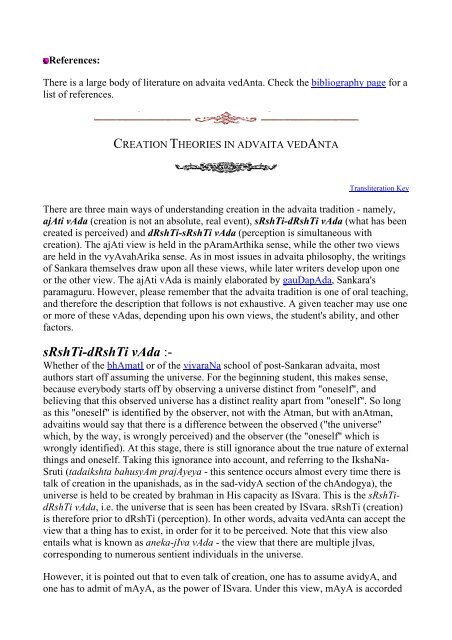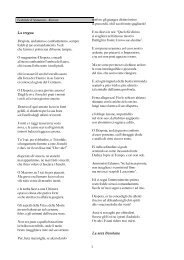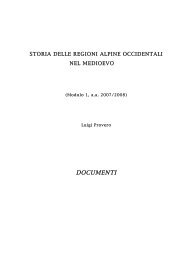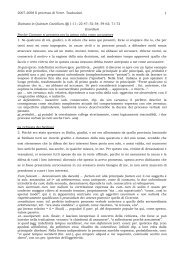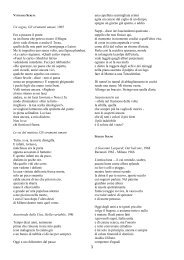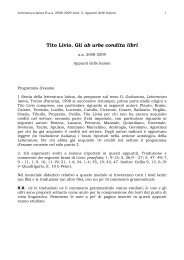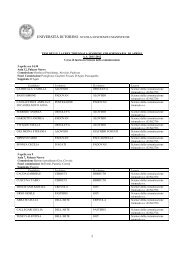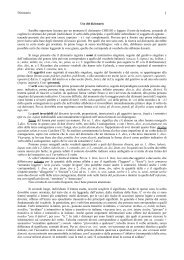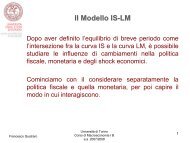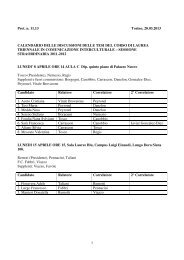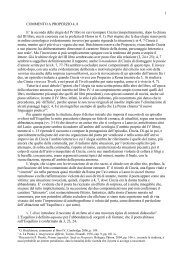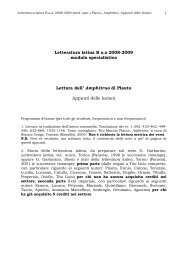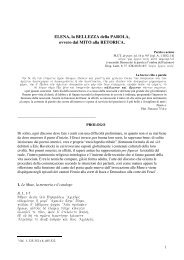ajAti vAda
ajAti vAda
ajAti vAda
You also want an ePaper? Increase the reach of your titles
YUMPU automatically turns print PDFs into web optimized ePapers that Google loves.
References:<br />
There is a large body of literature on advaita vedAnta. Check the bibliography page for a<br />
list of references.<br />
CREATION THEORIES IN ADVAITA VEDANTA<br />
Transliteration Key<br />
There are three main ways of understanding creation in the advaita tradition - namely,<br />
<strong>ajAti</strong> <strong>vAda</strong> (creation is not an absolute, real event), sRshTi-dRshTi <strong>vAda</strong> (what has been<br />
created is perceived) and dRshTi-sRshTi <strong>vAda</strong> (perception is simultaneous with<br />
creation). The <strong>ajAti</strong> view is held in the pAramArthika sense, while the other two views<br />
are held in the vyAvahArika sense. As in most issues in advaita philosophy, the writings<br />
of Sankara themselves draw upon all these views, while later writers develop upon one<br />
or the other view. The <strong>ajAti</strong> <strong>vAda</strong> is mainly elaborated by gauDapAda, Sankara's<br />
paramaguru. However, please remember that the advaita tradition is one of oral teaching,<br />
and therefore the description that follows is not exhaustive. A given teacher may use one<br />
or more of these <strong>vAda</strong>s, depending upon his own views, the student's ability, and other<br />
factors.<br />
sRshTi-dRshTi <strong>vAda</strong> :-<br />
Whether of the bhAmatI or of the vivaraNa school of post-Sankaran advaita, most<br />
authors start off assuming the universe. For the beginning student, this makes sense,<br />
because everybody starts off by observing a universe distinct from "oneself", and<br />
believing that this observed universe has a distinct reality apart from "oneself". So long<br />
as this "oneself" is identified by the observer, not with the Atman, but with anAtman,<br />
advaitins would say that there is a difference between the observed ("the universe"<br />
which, by the way, is wrongly perceived) and the observer (the "oneself" which is<br />
wrongly identified). At this stage, there is still ignorance about the true nature of external<br />
things and oneself. Taking this ignorance into account, and referring to the IkshaNa-<br />
Sruti (tadaikshta bahusyAm prajAyeya - this sentence occurs almost every time there is<br />
talk of creation in the upanishads, as in the sad-vidyA section of the chAndogya), the<br />
universe is held to be created by brahman in His capacity as ISvara. This is the sRshTidRshTi<br />
<strong>vAda</strong>, i.e. the universe that is seen has been created by ISvara. sRshTi (creation)<br />
is therefore prior to dRshTi (perception). In other words, advaita vedAnta can accept the<br />
view that a thing has to exist, in order for it to be perceived. Note that this view also<br />
entails what is known as aneka-jIva <strong>vAda</strong> - the view that there are multiple jIvas,<br />
corresponding to numerous sentient individuals in the universe.<br />
However, it is pointed out that to even talk of creation, one has to assume avidyA, and<br />
one has to admit of mAyA, as the power of ISvara. Under this view, mAyA is accorded


